|
NATIONAL PARK SERVICE
Park Structures and Facilities |

|
ENTRANCEWAYS
IN ITS SIMPLEST and, theoretically, its most desirable expression, the park entranceway is merely a trail or a roadway taking off from a highway and leading into an area dedicated to public use and enjoyment. But it is not long permitted to retain so simple a form. Immediately, demands for traffic safety, through elimination of the hazards of steep grades, sharp turns, narrow rights of way, and obstructions to vision, assert themselves, and the simple unobtrusive entranceway is doomed.
To increase the safety factor for automobiles leaving or entering the main traffic flow at the entrance take-off, the highway is first widened, then the entrance road. The intersections are transformed into sweeping curves. Tree and plant growth, and perhaps a hillside, which interfere with sixty-mile-speed vision are eliminated. A broad parking area is created. All, doubtless, necessary and inevitable "improvement," but the unself-conscious park entranceway, bleeding from the many wounds, expires.
It will be gloriously reborn, having sacrificed only its naive innocence for a myriad of more worldly values. Prompt to admit that the entranceway is more sinned against than sinning, we can but hope that artificiality and sophistication will not be too brazenly flaunted.
The intersection of the approach road with the main highway has become so prominent that the entranceway is forced to take measures in self-defense. It must strive to overcome the travelling public's quick conclusion that here is a new speedway, a relief route to a metropolis, or the gateway to some optimistic suburban subdivision.
A mere sign fails to clarify the impression. Pylons are resorted to in the hope of standing off the onrush of trucks and speeders. Gates are proposed. More often than not these succeed rather in be-speaking the modern "burial park" than the kind of park it is hoped to typify. There results confusion worse confounded; solution seems beyond reach. Is it then any wonder that flanking walls, lodges, towers, lights, concessions, arches—anything looks reasonable as an appendage that gives promise of proclaiming beyond question just what the entrance does, or failing this, does not, serve? The temptation is hardly resistible, and the entranceway, complex, impressive, institutional, evolves.
Once fully aware of the factors that deny this desired simplicity to the park designer, while concurrently hampering the success of the complicated alternative, it is well to take stock of just what, in spite of all unfavorable limitations, a park entranceway can be and convey.
It should at once invite and deter, encouraging use while discouraging abuse of the park by the public. It should be all things to all men, tempting the respecter of nature and of the past, while warding off and detouring that bloc of the public primarily bent on a greater and speedier gasoline consumption. A kind of semaphore simultaneously reading "stop" and "go," yet somehow avoiding accidents—to traffic and to temperament. Surely no easy accomplishment, perhaps unattainable.
The simple appeal and mystery of the rural lane denied us, we can seek to beckon by means of an approach road of inviting width. But the speeder bent on getting nowhere in particular with all possible haste must somehow be diplomatically urged in another direction. An island dividing the in and out traffic will promote safety and restrain recklessness without suggestion of inhospitality. If an admission fee is to be collected, an island kiosk is a very practical station point for collecting admissions and for the attendant duties of checking and providing information. From a kiosk so located, a guard can conveniently give information to departing patrons without undue interruption to the business of admissions. By recalling the familiar toll bridge entrance, it serves to suggest to the entrant that a fee is to be collected, and saves time that with any other arrangement might be consumed in query and explanation. The checking station, lodge, or sentry box to one side of the entranceway is sometimes preferred, especially when the traffic flow is not heavy. There are shown herein some successful examples of these several arrangements.
For a proper control, entranceways to many parks must serve as barriers during certain hours. Gates become a practical necessity. A pretentious rendering is apt to suggest an institution. Probably the low gate, related in appearance to the familiar log barrier of the parking area, and pivoting at one end for operation, is the happiest solution. It serves adequately as barrier and does not obscure, nor presume to compete with, the landscape beyond. Among examples of this type, the gate of the checking station at Turner Falls, Oklahoma, is of exceptional merit. A chain barrier is an even simpler solution, but should always be equipped with a conspicuous sign or otherwise be made readily visible under automobile headlights.
In specific instances, a custodian's dwelling or lodge may necessarily and logically be incorporated with the entranceway. The connotation of gate lodge guarding a country estate is then to be avoided. When any portion of the using public is transported to the park by common carrier, a sheltered waiting space, as an adjunct of the entranceway, has a real function.
Overhead construction, utilizing arch or lintel, perhaps overdone in an earlier era, seems not to find wide current favor. Doubtless this results from a worthy desire to avoid any feeling of confinement, or any subconscious recall of the triumphal arch and staff creations long associated with street parades and carnivals.
The speed and conditions of present day traffic in which the car is quicker than the eye, dictate that the public be given timely warning and vision of its approach to the park entranceway. In order that brakes may be applied effectively at prevalent, popular speeds, a considerable stretch of highway border is affected. While conservation of all possible forest cover may be the primary and praiseworthy objective of the natural park enthusiast, it is urged that it yield precedence outside the entrance gate to the demands for safety. The practical advantages to be derived from the placement of any entrance features well back from the main highway, and the maintenance of suitably cleared sight lines, must be acknowledged by all as paramount.
The park entranceway may meet all the requirements of function and many of the standards of beauty and yet fall far short of its potentialities. As the outpost of a reserved area offering certain distinctive recreational opportunities to the public, it can with subtlety and grace, project the promise and lure of the region and its offered recreation to the very public highway. The truly successful entranceway will be contrived to be the simple essence of the park's characteristics to no resultant interference with the basic and material functions of ingress, egress and barrier.

|
| Plate A-1 (click on image for a PDF version) |

|
| Plate A-2 (click on image for a PDF version) |

|
| Plate A-3 (click on image for a PDF version) |
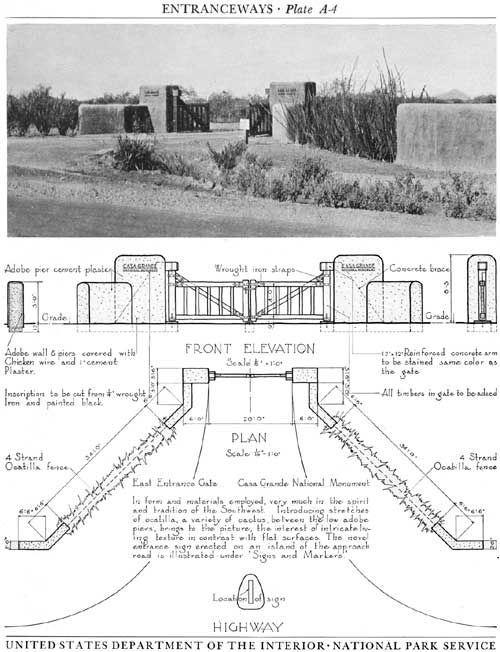
|
| Plate A-4 (click on image for a PDF version) |
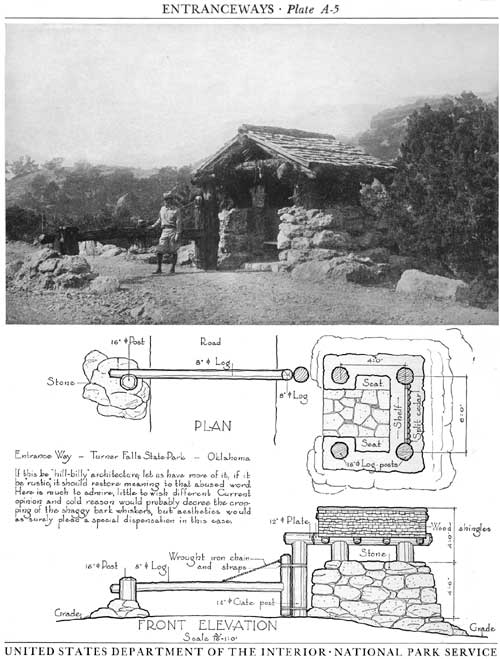
|
| Plate A-5 (click on image for a PDF version) |

|
| Plate A-6 (click on image for a PDF version) |
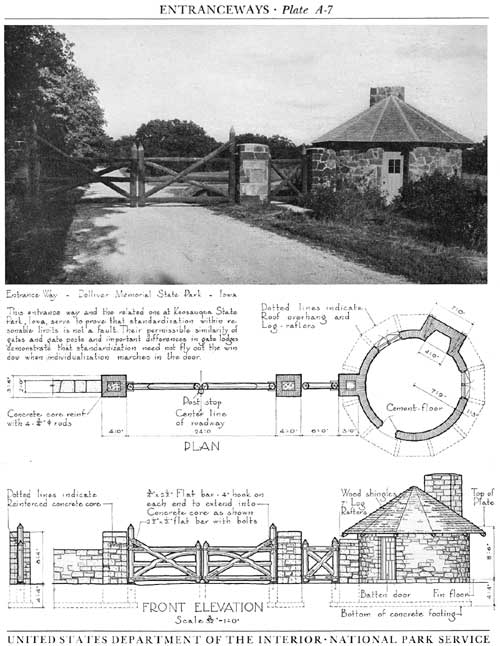
|
| Plate A-7 (click on image for a PDF version) |
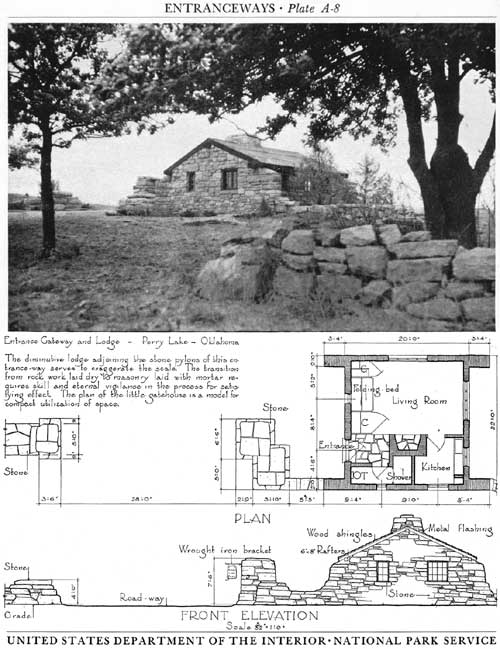
|
| Plate A-8 (click on image for a PDF version) |
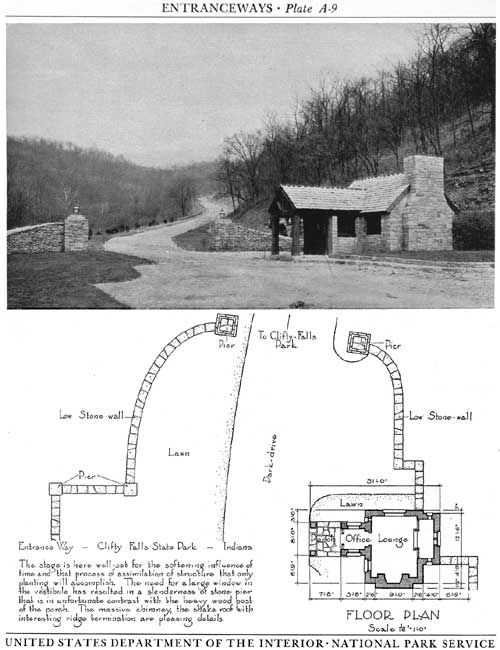
|
| Plate A-9 (click on image for a PDF version) |
Stone Pylons
Various and sundry entrance pylons surround this caption. The range is considerable in silhouette, and in formality and technique of masonry as well. The tall pylon having extended wooden arm with suspended sign designating the park is a popular arrangement. Again, a panel carrying the name of the park is built into the face of the pylon. There are many possibilities for novelty within the bounds of good taste that are by no means exhausted by the few examples it is possible to show in this limited space. Important as agreeable mass and well-built stone work, is the appearance of stability, adequate bulk and permanence in pylons.

|
| Plate A-10 (click on image for a PDF version) |

|
| Cape San Sebastian State Park, Oregon |
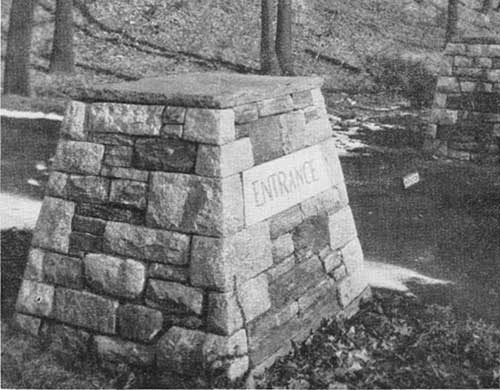
|
| Echo Lake Picnic Area, New York |
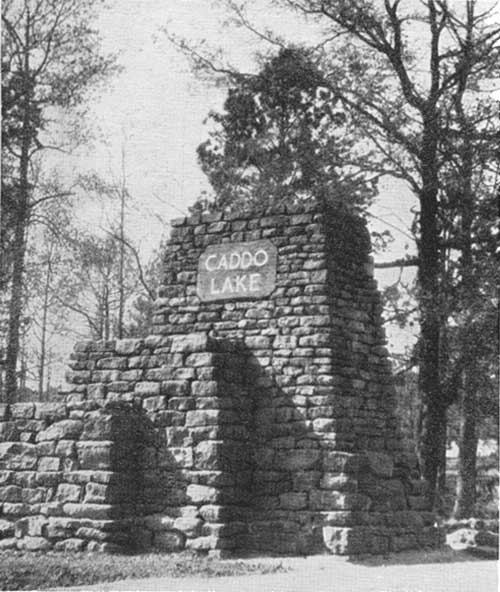
|
| Caddo Lake State Park, Texas |
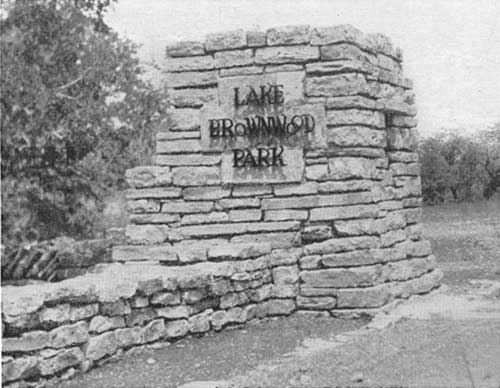
|
| Lake Brownwood State Park, Texas |

|
| Plate A-11 (click on image for a PDF version) |

|
| Letchworth State Park, New York |
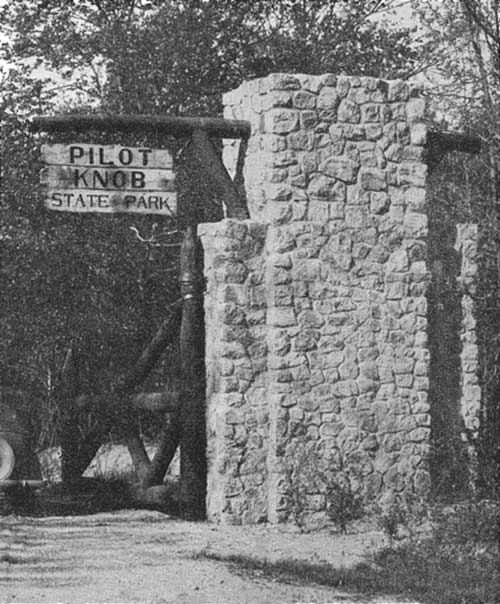
|
| Pilot Knob State Park, Iowa |
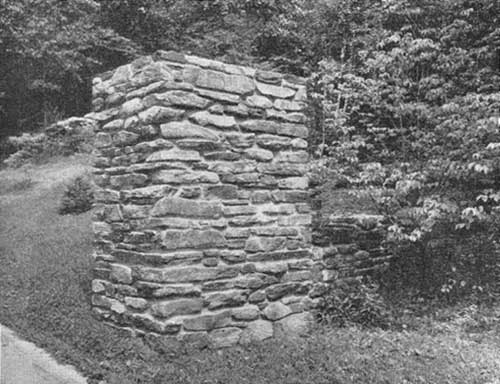
|
| Taconic State Park, New York |
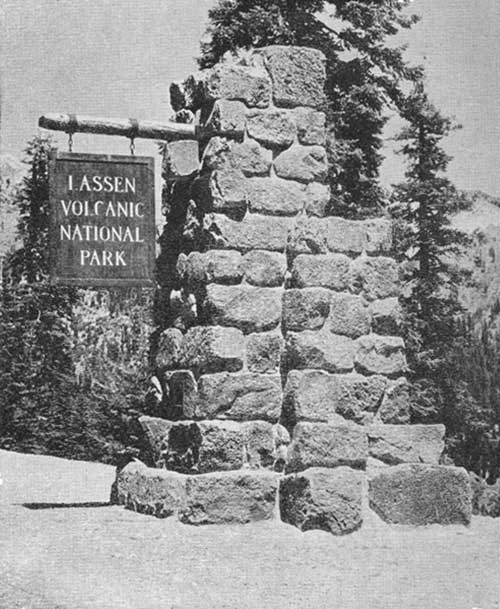
|
| Raker Memorial, Lassen Volcanic National Park |
Entrance Checking Station, Mt. Rainier National Park
A splendid log structure deserving of the impressive background it enjoys. Only the trivial chimneys fail to register to the high standards all other details maintain. The log work and the scale of the rafters, purlins and shake roof with pole-capped ridge, are excellently handled. The low log barrier in addition to practical purpose serves to link the log construction with the surroundings. There is a well-tended neatness about this structure and setting untypical of wilderness areas generally, yet somehow not discordant here.
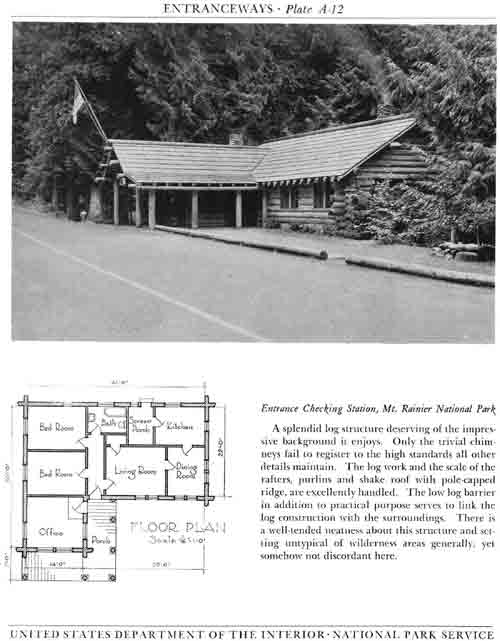
|
| Plate A-12 (click on image for a PDF version) |
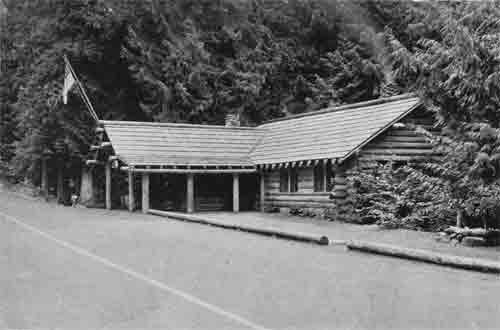
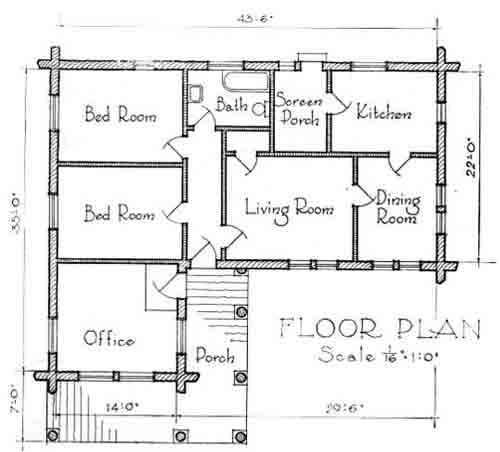
| <<< Previous | <<< Contents>>> | Next >>> |
park_structures_facilities/seca.htm
Last Updated: 5-Dec-2011